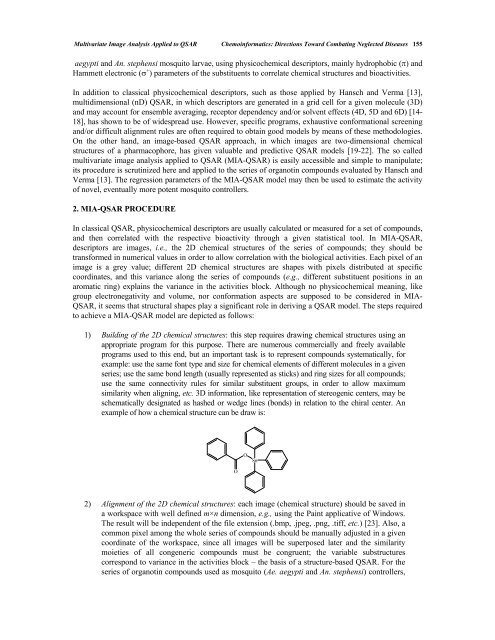chapter 1 - Bentham Science
chapter 1 - Bentham Science
chapter 1 - Bentham Science
You also want an ePaper? Increase the reach of your titles
YUMPU automatically turns print PDFs into web optimized ePapers that Google loves.
Multivariate Image Analysis Applied to QSAR Chemoinformatics: Directions Toward Combating Neglected Diseases 155<br />
aegypti and An. stephensi mosquito larvae, using physicochemical descriptors, mainly hydrophobic () and<br />
Hammett electronic ( + ) parameters of the substituents to correlate chemical structures and bioactivities.<br />
In addition to classical physicochemical descriptors, such as those applied by Hansch and Verma [13],<br />
multidimensional (nD) QSAR, in which descriptors are generated in a grid cell for a given molecule (3D)<br />
and may account for ensemble averaging, receptor dependency and/or solvent effects (4D, 5D and 6D) [14-<br />
18], has shown to be of widespread use. However, specific programs, exhaustive conformational screening<br />
and/or difficult alignment rules are often required to obtain good models by means of these methodologies.<br />
On the other hand, an image-based QSAR approach, in which images are two-dimensional chemical<br />
structures of a pharmacophore, has given valuable and predictive QSAR models [19-22]. The so called<br />
multivariate image analysis applied to QSAR (MIA-QSAR) is easily accessible and simple to manipulate;<br />
its procedure is scrutinized here and applied to the series of organotin compounds evaluated by Hansch and<br />
Verma [13]. The regression parameters of the MIA-QSAR model may then be used to estimate the activity<br />
of novel, eventually more potent mosquito controllers.<br />
2. MIA-QSAR PROCEDURE<br />
In classical QSAR, physicochemical descriptors are usually calculated or measured for a set of compounds,<br />
and then correlated with the respective bioactivity through a given statistical tool. In MIA-QSAR,<br />
descriptors are images, i.e., the 2D chemical structures of the series of compounds; they should be<br />
transformed in numerical values in order to allow correlation with the biological activities. Each pixel of an<br />
image is a grey value; different 2D chemical structures are shapes with pixels distributed at specific<br />
coordinates, and this variance along the series of compounds (e.g., different substituent positions in an<br />
aromatic ring) explains the variance in the activities block. Although no physicochemical meaning, like<br />
group electronegativity and volume, nor conformation aspects are supposed to be considered in MIA-<br />
QSAR, it seems that structural shapes play a significant role in deriving a QSAR model. The steps required<br />
to achieve a MIA-QSAR model are depicted as follows:<br />
1) Building of the 2D chemical structures: this step requires drawing chemical structures using an<br />
appropriate program for this purpose. There are numerous commercially and freely available<br />
programs used to this end, but an important task is to represent compounds systematically, for<br />
example: use the same font type and size for chemical elements of different molecules in a given<br />
series; use the same bond length (usually represented as sticks) and ring sizes for all compounds;<br />
use the same connectivity rules for similar substituent groups, in order to allow maximum<br />
similarity when aligning, etc. 3D information, like representation of stereogenic centers, may be<br />
schematically designated as hashed or wedge lines (bonds) in relation to the chiral center. An<br />
example of how a chemical structure can be draw is:<br />
O<br />
O<br />
2) Alignment of the 2D chemical structures: each image (chemical structure) should be saved in<br />
a workspace with well defined m×n dimension, e.g., using the Paint applicative of Windows.<br />
The result will be independent of the file extension (.bmp, .jpeg, .png, .tiff, etc.) [23]. Also, a<br />
common pixel among the whole series of compounds should be manually adjusted in a given<br />
coordinate of the workspace, since all images will be superposed later and the similarity<br />
moieties of all congeneric compounds must be congruent; the variable substructures<br />
correspond to variance in the activities block – the basis of a structure-based QSAR. For the<br />
series of organotin compounds used as mosquito (Ae. aegypti and An. stephensi) controllers,<br />
Sn

















